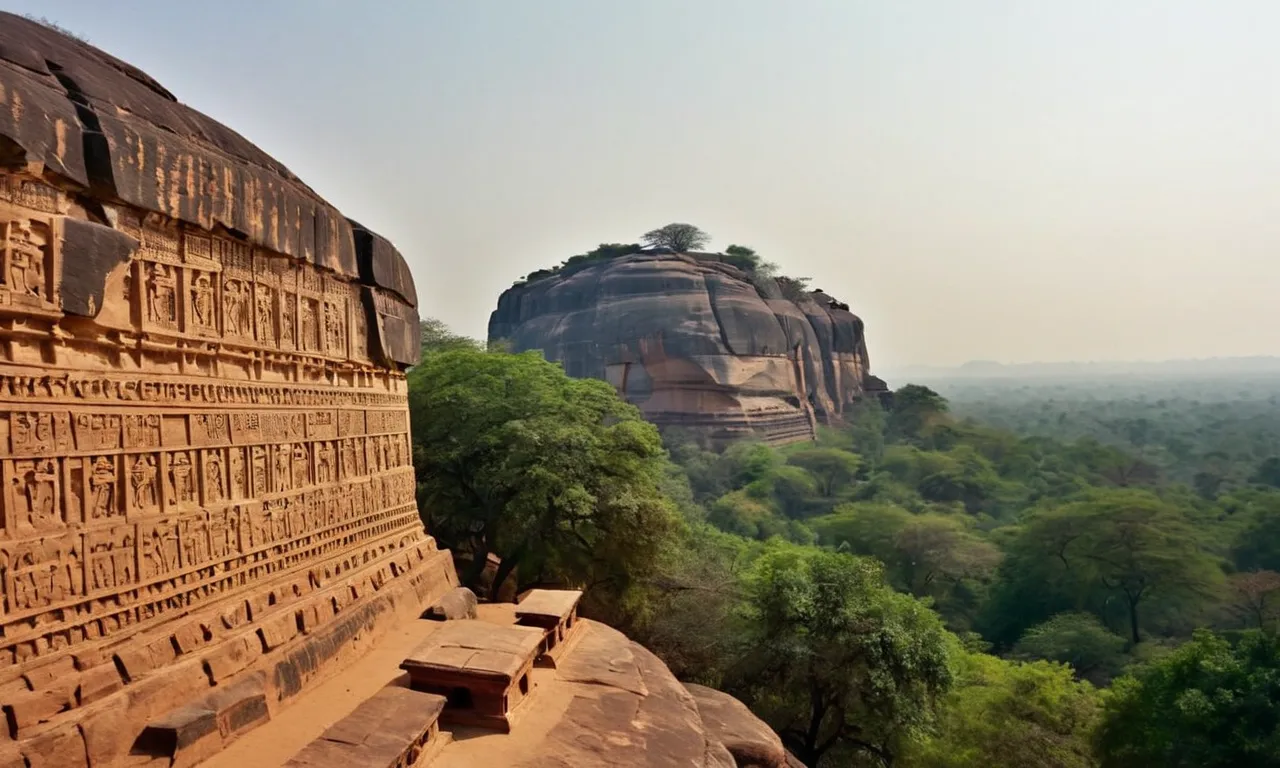How Did Religion Influence The Mauryan Empire?
The Mauryan Empire was one of the largest and most powerful empires in ancient India. At its height under Ashoka, it covered nearly all of the Indian subcontinent. Religion played a major role in the rise and governance of this empire.
If you’re short on time, here’s a quick answer: Buddhism significantly influenced the Mauryan Empire during the reign of Emperor Ashoka, leading him to renounce violence and war, promote religious tolerance, and support the spread of Buddhism within and outside his empire.
In this nearly 3000 word article, we will analyze the religious landscape in India before and during the Mauryan rule, examine how the empire’s early rulers like Chandragupta Maurya and Bindusara related to different faiths, detail Emperor Ashoka’s conversion to Buddhism and its effects on his policies and public works, assess Buddhism’s impacts on art, architecture and culture under the Mauryans, and summarize the legacy of this Buddhist influence on later Indian dynasties.
Religious Diversity in Pre-Mauryan India
Vedic Brahmanism
Vedic Brahmanism was one of the most influential religious traditions in pre-Mauryan India. It emerged from the Vedic period, when the Vedas, some of the earliest Hindu scriptures, were composed. Vedic Brahmanism centered around rituals and sacrifices performed by Brahmin priests.
The priests would recite mantras and make offerings into the sacrificial fire for the gods. Major deities included Indra, Agni, and Soma. Adherence to the caste system was important, with Brahmins sitting atop the social hierarchy. This belief system helped shape Indian social structure for centuries.
However, by the 6th century BCE, Vedic Brahmanism was in decline as new religious ideas emerged.
Jainism
Jainism arose in the 6th century BCE as a reaction to the Vedic rituals and caste system. As per tradition, it was founded by Mahavira, a contemporary of Buddha. Jains believe in the existence of an eternal human soul bound by karma in a never-ending cycle of rebirths.
To attain liberation, one must live an ascetic life devoid of violence to all living beings. The three guiding principles are right faith, right knowledge, and right conduct. Jain monastic tradition is extremely rigorous even by Indian standards.
Lay followers must adhere to vows like non-violence and truthfulness. In the pre-Mauryan era, Jainism spread across northern India. The religion’s ascetic values contrasted sharply with Vedic Brahmanism.
Local Cults and Sects
Apart from the major religions, local cults and sects thrived across India. Village and tribal folk religions were quite common. Local deities were worshipped through simple rituals overseen by shamans. Examples included Yaksha and Yakshini cults.
Tree spirits and nagas were also venerated. Fertility rituals and worship of Mother Goddess were widespread. Shaktism, focused on female deities, became more prominent. Hero stone memorials called naga kal were erected to commemorate heroic death in battle. Occult practices like astrology and alchemy were pursued by some groups.
Cults like Pashupata Shaivism and Bhagavata tradition emerged. Thus local sects satisfied popular spiritual needs beyond Brahmanical religion. The diversity paved way for future religious syntheses under the Mauryas.
Early Mauryan Rulers’ Religious Patronage
Chandragupta Maurya’s Eclectic Support
Chandragupta Maurya, the founder of the Mauryan Empire, practiced an eclectic and pragmatic approach toward religion. He did not subscribe to a single faith but supported a variety of religious traditions.
According to ancient sources, Chandragupta consulted with Jain monks and even performed austerity practices and fasts in the Jain tradition toward the end of his life. However, early in his reign, Chandragupta also heavily patronized Brahmanical Hinduism and gifted land grants to Brahmin priests.
In addition, he allowed Greek ambassador Megasthenes to establish a Greek colony in his capital where Greek religious rites could be practiced. Chandragupta’s motivation appeared to be more political than spiritual – he aimed to win the support of diverse religious groups within his vast empire.
His eclectic patronage allowed him to appeal to all major faiths in the Indian subcontinent at the time.
Bindusara’s Promotion of Ajivikas
Bindusara, the son and successor of Chandragupta Maurya, was a major patron of the Ajivika sect. Ajivikas were an ascetic religious movement in ancient India that emphasized strict fatalism and determinism. Bindusara is said to have donated several rock-cut caves to Ajivika monks.
The most famous of these was the Barabar Caves near Gaya, which contain some of the earliest surviving stone carvings in India. Bindusara also appointed an Ajivika monk named Pingalavatsa as his spiritual teacher. Interestingly, Bindusara did not exclusively support Ajivikas.
Like his father, he continued the eclectic and pluralistic religious policy of the early Mauryas. For example, he allowed Brahminical rituals to be conducted at his court. However, his preference for Ajivika philosophy reveals his inclination toward fatalistic and ascetic traditions rather than Vedic Hinduism.
Ashoka’s Conversion to Buddhism
The Mauryan Emperor Ashoka initially followed Hinduism but later converted to Buddhism after witnessing the mass deaths from his invasion of Kalinga. This conversion profoundly shaped his rule and the religious landscape of ancient India.
The Kalinga War and Its Aftermath
Ashoka launched a brutal invasion of Kalinga, an independent kingdom on the east coast of India, in approximately 262 BCE. After an intensely bloody campaign, Ashoka succeeded in conquering Kalinga and incorporating it into his Mauryan Empire.
However, Ashoka was horrified by the terrible violence and mass suffering unleashed by his military conquest. Ancient sources suggest over 100,000 people died in the war, with even more injured or displaced.
This shocking loss of human life led Ashoka to bitterly regret his actions and begin seriously examining Buddhist principles of non-violence and compassion.
Ashoka’s Edicts and Dhamma Policy
After his conversion, Ashoka made Buddhism the state religion of the Mauryan Empire and implemented Buddhist moral principles in his rule. He issued edicts carved onto pillars and rocks across India promoting religious tolerance, non-violence, respect for all life, and other key tenets of Buddhism.
A core aspect of Ashoka’s rule was the policy of Dhamma, which emphasized Buddhist morality, justice, and social welfare. For instance, Ashoka greatly expanded humanitarian aid, building roads, hospitals, and water sources to improve his subjects’ lives.
He also banned many violent practices, like animal sacrifices, and reduced the number of tax collections.
According to some historians, over Ashoka’s approximately 40-year reign he established around 84,000 Buddhist monasteries and shrines across the subcontinent. His patronage was crucial in spreading Buddhism through India and beyond.
While Ashoka did not ban other religions, his strong support of Buddhism transformed it into the most prominent faith in India at the time. It also shaped social values and norms around non-violence that endured for centuries.
Descendants of the Mauryan imperial family would support Buddhism for generations until its decline in India hundreds of years later.
So in many ways, Ashoka’s conversion after the Kalinga War and subsequent Buddhist policies fundamentally changed the religious identity of the Mauryan Empire and left a profound imprint on Indian history.
Impacts on Art, Architecture and Culture
Buddhist Monuments and Sculptures
The Mauryan Empire saw a tremendous growth in Buddhist art and architecture. Emperor Ashoka was a great patron of Buddhism and commissioned the construction of numerous stupas, pillars and rock edicts across his empire to spread the teachings of Buddha.
Some of the most notable Buddhist monuments from the Mauryan period include the Great Stupa at Sanchi, the rock-cut chaitya halls at Ajanta and Ellora caves, and the Pillars of Ashoka erected all over northern India.
The most outstanding contribution was the sculpture art that flourished under the Mauryas. The stone sculptures at Sanchi and Barhut stupas represent some of the finest specimens of Mauryan art. These sculptures depicted various events from the life of Buddha as well as Jataka tales.
The figures show grace, beauty and spirituality. The dome shaped stupas were also adorned with carvings that presented Buddhist themes.
Spread of Buddhism Beyond India
The Mauryan empire’s promotion of Buddhism had far reaching consequences beyond India. Ashoka sent Buddhist missions to Sri Lanka to propagate the religion. This led to Buddhism becoming the national religion of Sri Lanka.
Ashoka’s son Mahinda and daughter Sanghamitra actively preached Buddhism in Sri Lanka.
Likewise, many Buddhist monks from India traveled to Central Asia and China taking Buddha’s teachings along the Silk Route. This paved the way for the spread of Buddhism across entire Central Asia and East Asia.
The religion found patronage under the Kushana rulers who ruled parts of northern India and Central Asia. Thus, the Mauryan empire played a seminal role in spreading Buddhist art, architecture and culture into many Asian regions. This helped Buddhism emerge as a major world religion from its origin in India.
Legacy for Later Indian Dynasties
The Mauryan Empire, founded by Chandragupta Maurya in 321 BCE, was the first major pan-Indian empire in ancient India. Though relatively short-lived, lasting only around 150 years, the Mauryan Empire left an important legacy for later Indian dynasties.
Here are some of the key ways the Mauryan Empire influenced future rulers and kingdoms in India:
Unification of Most of India
For the first time, the Mauryan Empire brought together much of the Indian subcontinent under the rule of an imperial dynasty. This set a precedent for future rulers to try to control large swathes of Indian territory.
The Mauryas demonstrated that such a vast and culturally diverse land could indeed be unified under a central administration. This legacy of conquest and expansion inspired later dynasties like the Guptas.
Efficient Administration
To govern their vast territories, the Mauryas established a sophisticated administrative system that later served as a model. Key features included:
- A centralized bureaucracy for making policies.
- A hierarchical structure for officials overseeing local, regional, and imperial operations.
- Standardized law codes and policies for governing different parts of the empire uniformly.
- State control and taxation of resources to fund imperial infrastructure and activities.
The administrative innovations pioneered by the Mauryas were adopted and further developed by later dynasties seeking to exert imperial authority.
Patronage of Religions
Religious diversity flourished under the relatively tolerant Mauryas. Although Hinduism remained important, Buddhism, Jainism, and Ajivika philosophy also thrived with state patronage during this period.
Later dynasties similarly patronized multiple religious traditions. This ecumenical approach helped syncretic cultures develop in India over time.
Trade Relations
The Mauryas established trade connections and diplomatic exchanges as far away as the Mediterranean. This helped connect India to the wider world during antiquity.
Later dynasties continued cultivating such commercial and foreign ties. For example, the Guptas maintained relations with imperial Rome. This helped make India an important hub in the global trade networks of pre-modern eras.
In many ways, the Mauryan Empire laid the foundations for later Indian kingdoms and dynasties. Though it lasted only a relatively brief period, the Mauryas pioneered key administrative, religious, economic, and political traditions that proved influential long after their own decline.
Conclusion
In conclusion, Buddhism exerted a profound influence on India’s Mauryan Empire, especially under Emperor Ashoka. His conversion and support led to major impacts on Mauryan governance, public works, art and culture, and the subsequent spread of Buddhism across Asia.
The Mauryan period represents a high point for Buddhist advancement in Indian history, setting the stage for its continued influence in later dynasties.








